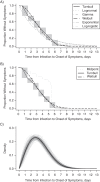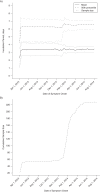Estimating the Distribution of the Incubation Periods of Human Avian Influenza A(H7N9) Virus Infections
- PMID: 26409239
- PMCID: PMC4597801
- DOI: 10.1093/aje/kwv115
Estimating the Distribution of the Incubation Periods of Human Avian Influenza A(H7N9) Virus Infections
Abstract
A novel avian influenza virus, influenza A(H7N9), emerged in China in early 2013 and caused severe disease in humans, with infections occurring most frequently after recent exposure to live poultry. The distribution of A(H7N9) incubation periods is of interest to epidemiologists and public health officials, but estimation of the distribution is complicated by interval censoring of exposures. Imputation of the midpoint of intervals was used in some early studies, resulting in estimated mean incubation times of approximately 5 days. In this study, we estimated the incubation period distribution of human influenza A(H7N9) infections using exposure data available for 229 patients with laboratory-confirmed A(H7N9) infection from mainland China. A nonparametric model (Turnbull) and several parametric models accounting for the interval censoring in some exposures were fitted to the data. For the best-fitting parametric model (Weibull), the mean incubation period was 3.4 days (95% confidence interval: 3.0, 3.7) and the variance was 2.9 days; results were very similar for the nonparametric Turnbull estimate. Under the Weibull model, the 95th percentile of the incubation period distribution was 6.5 days (95% confidence interval: 5.9, 7.1). The midpoint approximation for interval-censored exposures led to overestimation of the mean incubation period. Public health observation of potentially exposed persons for 7 days after exposure would be appropriate.
Keywords: incubation period; influenza; influenza A virus; influenza A(H7N9).
© The Author 2015. Published by Oxford University Press on behalf of the Johns Hopkins Bloomberg School of Public Health. All rights reserved. For permissions, please e-mail: journals.permissions@oup.com.
Figures


Similar articles
-
Evaluation of animal-to-human and human-to-human transmission of influenza A (H7N9) virus in China, 2013-15.Sci Rep. 2018 Jan 11;8(1):552. doi: 10.1038/s41598-017-17335-9. Sci Rep. 2018. PMID: 29323268 Free PMC article.
-
Estimated Incubation Period and Serial Interval for Human-to-Human Influenza A(H7N9) Virus Transmission.Emerg Infect Dis. 2019 Oct;25(10):1982-1983. doi: 10.3201/eid2510.190117. Epub 2019 Oct 17. Emerg Infect Dis. 2019. PMID: 31264568 Free PMC article.
-
Transmission potential of the novel avian influenza A(H7N9) infection in mainland China.J Theor Biol. 2014 Jul 7;352:1-5. doi: 10.1016/j.jtbi.2014.02.038. Epub 2014 Mar 6. J Theor Biol. 2014. PMID: 24607746
-
Viral lung infections: epidemiology, virology, clinical features, and management of avian influenza A(H7N9).Curr Opin Pulm Med. 2014 May;20(3):225-32. doi: 10.1097/MCP.0000000000000047. Curr Opin Pulm Med. 2014. PMID: 24637225 Review.
-
H7N9: preparing for the unexpected in influenza.Annu Rev Med. 2015;66:361-71. doi: 10.1146/annurev-med-010714-112311. Epub 2014 Oct 29. Annu Rev Med. 2015. PMID: 25386931 Review.
Cited by
-
Modeling Global COVID-19 Dissemination Data After the Emergence of Omicron Variant Using Multipronged Approaches.Curr Microbiol. 2022 Aug 10;79(9):286. doi: 10.1007/s00284-022-02985-4. Curr Microbiol. 2022. PMID: 35947199 Free PMC article.
-
Robust estimation of the incubation period and the time of exposure using γ-divergence.J Appl Stat. 2024 Nov 6;52(6):1239-1257. doi: 10.1080/02664763.2024.2420221. eCollection 2025. J Appl Stat. 2024. PMID: 40303570 Free PMC article.
-
Assessment of Human-to-Human Transmissibility of Avian Influenza A(H7N9) Virus Across 5 Waves by Analyzing Clusters of Case Patients in Mainland China, 2013-2017.Clin Infect Dis. 2019 Feb 1;68(4):623-631. doi: 10.1093/cid/ciy541. Clin Infect Dis. 2019. PMID: 29961834 Free PMC article.
-
Estimation of incubation period and serial interval of COVID-19: analysis of 178 cases and 131 transmission chains in Hubei province, China.Epidemiol Infect. 2020 Jun 19;148:e117. doi: 10.1017/S0950268820001338. Epidemiol Infect. 2020. PMID: 32594928 Free PMC article.
-
The effects of local homogeneity assumptions in metapopulation models of infectious disease.R Soc Open Sci. 2022 Jul 13;9(7):211919. doi: 10.1098/rsos.211919. eCollection 2022 Jul. R Soc Open Sci. 2022. PMID: 35845852 Free PMC article.
References
Publication types
MeSH terms
Grants and funding
LinkOut - more resources
Full Text Sources
Other Literature Sources
Medical
Molecular Biology Databases

